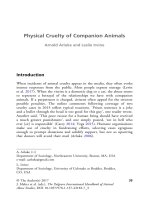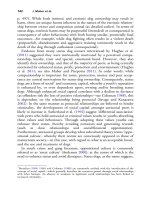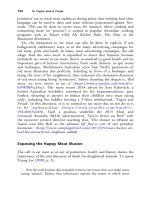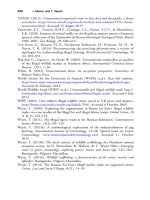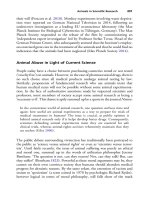The palgrave international handbook of a 152
Bạn đang xem bản rút gọn của tài liệu. Xem và tải ngay bản đầy đủ của tài liệu tại đây (29.12 KB, 1 trang )
Status Dogs
143
are a vehicle for enhancing status and can become an extension of their
owner’s status within social groups. In this culture a dog’s worth to their
owner is measured by their street value (or status). Failure to successfully
engage in desirable ‘street’ behaviours (for example, protection, displays of
toughness and aggression) diminishes this value. Consequently status dogs
are required to live the same ‘code of the street’ (a set of unwritten rules that
must be followed by those engaging in street culture—Anderson 2000) as
their owners and are subjected to violent challenges by other youths and
their dogs. According to Evans et al. (cited in Ortiz 2009), status dogs
(through informal dog fighting—see also the chapter on Animal Fighting
herein) reportedly help resolve US street/gang conflicts allowing youths to
validate their masculinity while remaining on the periphery of actual interpersonal violence (Evans et al. cited in Ortiz)). Accordingly, it is not unusual to
find that youths are profiling dogs (looking for specific ‘status’ characteristics,
such as size, strength, aggression, toughness and resilience to pain) and then
breeding for these characteristics (Hughes et al. 2011). Furthermore, harsh
treatment by their owners is often required for the dogs to play their role. When
they are no longer able to perform or their value plummets they are expendable
and easily replaced. Using these theoretical perspectives, an explanation for the
harm and abuse experienced by these dogs at the hands of their owners becomes
discernible.
Status dogs are, arguably, one element of a ‘unified phenomenon of
antisocial and violent behaviour’ (Arluke et al. 1999). This is consistent
with the deviance generalisation hypothesis which maintains that animal
abuse—especially amongst youths—is linked extensively to human interpersonal violence (Arluke et al. 1999; Ascione 1993, 2001) and criminality
(Degenhardt 2005). Violence and harm towards animals may occur concurrently or separately to interpersonal violence and criminality. This is
evidenced in Degenhardt’s (2005) Chicago Police Department study,
which identified animal abuse offenders were more likely to carry and use
firearms and engage in the sale of drugs and with street gangs than nonanimal abuse offenders. More specifically, in relation to status dogs, Barnes
et al. (2006) found that US status dog owners had significantly more
criminal convictions for serious crimes (that is crimes featuring aggression/violence or firearms, or involving drugs or children) than non-status
dog owners. It is therefore reasonable to propose that status dog ownership,
and its associated animal harms, occurs as part of a complex offending
pattern exhibited by deviant youths.
To further the explanation of status dog ownership it is essential to ask the
question—why do certain dog types provide status for youths? In line with
